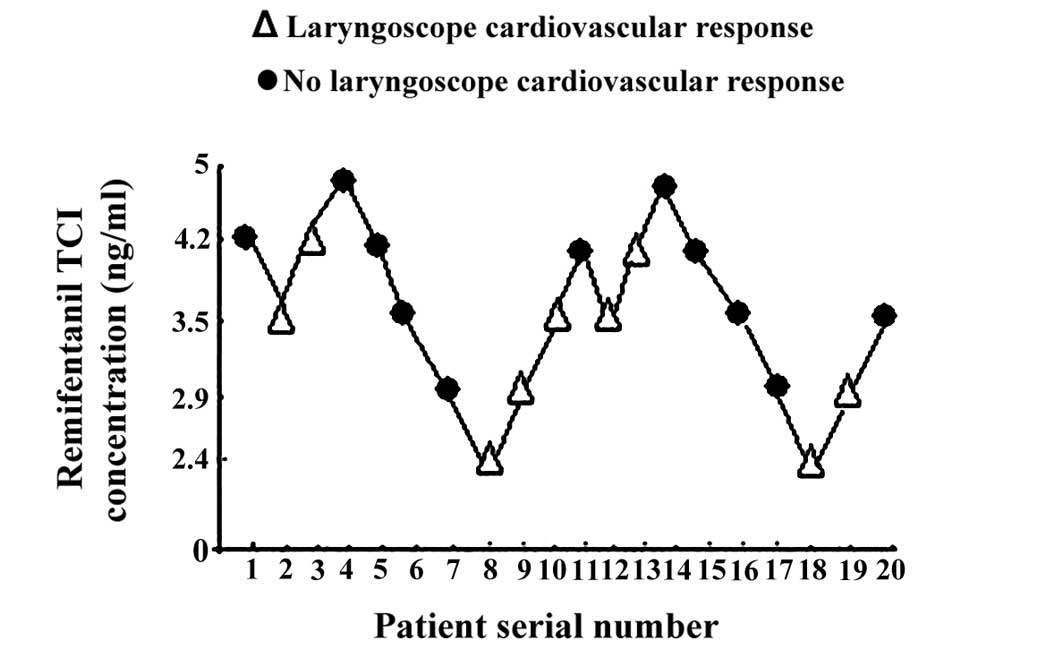|
1
|
Ghause MS, Singh V, Kumar A, Wahal R,
Bhatia VK and Agarwal J: A study of cardiovascular response during
laryngoscopy and intubation and their attenuation by ultra short
acting b-blocker esmolol. Indian J Anaesth. 46:104–106. 2002.
|
|
2
|
Yumoto E: Laryngeal surgery-vocal cord
polyp and anaesthesia. Nihon Jibiinkoka Gakkai Kaiho. 116:34–37.
2013.(In Japanese). View Article : Google Scholar : PubMed/NCBI
|
|
3
|
Yoo HS, Han JH, Park SW and Kim KS:
Comparison of surgical condition in endoscopic sinus surgery using
remifentanil combined with propofol, sevoflurane, or desflurane.
Korean J Anesthesiol. 59:377–382. 2010. View Article : Google Scholar : PubMed/NCBI
|
|
4
|
Egan TD: Remifentanil: An
esterase-metabolized opioid. West J Med. 166:2021997.PubMed/NCBI
|
|
5
|
Myre K, Raeder J, Rostrup M, Buanes T and
Stokland O: Catecholamine release during laparoscpic fundoplication
with high and low doses of remifentanil. Acta Anaesthesiol Scand.
47:267–273. 2003. View Article : Google Scholar : PubMed/NCBI
|
|
6
|
Wu J, Mahmoud M, Schmitt M, Hossain M and
Kurth D: Comparison of propofol and dexmedetomedine techniques in
children undergoing magnetic resonance imaging. Paediatr Anaesth.
24:813–818. 2014. View Article : Google Scholar : PubMed/NCBI
|
|
7
|
Sieg A bng-Study-Group, Beck S, Scholl SG,
Heil FJ, Gotthardt DN, Stremmel W, Rex DK and Friedrich K: Safety
analysis of endoscopist-directed propofol sedation: A prospective,
national multicenter study of 24441 patients in German outpatient
practices. J Gastroenterol Hepatol. 29:517–523. 2014. View Article : Google Scholar : PubMed/NCBI
|
|
8
|
Khan HA, Umar M, Tul-Bushra H, Nisar G,
Bilal M and Umar S: Safety of non-anaesthesiologist-administered
propofol sedation in ERCP. Arab J Gastroenterol. 15:32–35. 2014.
View Article : Google Scholar : PubMed/NCBI
|
|
9
|
Minto CF, Schnider TW and Shafer SL:
Pharmacokinetics and pharmacodynamics of remifentanil. II. Model
application. Anesthesiology. 86:24–33. 1997. View Article : Google Scholar : PubMed/NCBI
|
|
10
|
Coetzee JF, Glen JB, Wium CA and Boshoff
L: Pharmacokinetic model selection for target controlled infusions
of propofol. Anesthesiol. 82:1328–1345. 1995. View Article : Google Scholar
|
|
11
|
Minto CF, Schnider TW and Shafer SL:
Pharmacokinetics and pharmacodynamics of remifentanil. II. Model
application. Anesthesiology. 86:24–33. 1997. View Article : Google Scholar : PubMed/NCBI
|
|
12
|
Chernik DA, Gillings D, Laine H, Hendler
J, Silver JM, Davidson AB, Schwam EM and Siegel JL: Validity and
reliability of the Observers Assessment of Alertness/Sedation
scale: Study with intravenous midazolam. J Clin Psychopharmacol.
10:244–251. 1990.PubMed/NCBI
|
|
13
|
Yang SQ: China Medical Encyclopedia -
Medical Statistics (1st). Shanghai Science and Technology Press.
Shanghai: 203–204. 2011.
|
|
14
|
Haussmann MF, Vleck CM and Farrar ES: A
laboratory exercise to illustrate increased salivary cortisol in
response to three stressful conditions using competitive ELISA. Adv
Physiol Educ. 31:110–115. 2007. View Article : Google Scholar : PubMed/NCBI
|
|
15
|
Okholm C, Goetze JP, Svendsen LB and
Achiam MP: Inflammatory response in laparoscopic vs. open surgery
for gastric cancer. Scand J Gastroenterol. 49:1027–1034. 2014.
View Article : Google Scholar : PubMed/NCBI
|
|
16
|
Wang SZ, Chen Y, Lin HY and Chen LW:
Comparison of surgical stress response to laparoscopic and open
radical cystectomy. World J Urol. 28:451–455. 2010. View Article : Google Scholar : PubMed/NCBI
|
|
17
|
Kristiansson M, Saraste L, Soop M,
Sundqvist KG and Thörne A: Diminished interleukin 6 and C reactive
protein response to laparoscopic versus open cholecystectomy. Acta
Anesthesiol Scand. 43:146–152. 1999. View Article : Google Scholar
|
|
18
|
Kehlet H: Multimodel approach to control
postoperative pathophysiology and rehabilitation. Br J Anaesth.
78:606–617. 1997. View Article : Google Scholar : PubMed/NCBI
|
|
19
|
Cooper GM, Scoggins AM, Ward ID and Murphy
D: Laparoscopy - a stressful procedure. Anaesthesia. 37:266–269.
1982. View Article : Google Scholar : PubMed/NCBI
|
|
20
|
Unlügenç H, Itegin M, Ocal I, Ozalevli M,
Güler T and Işik G: Remifentanil produces vasorelaxation in
isolated rat thoracic aorta strips. Acta Anaesthesiol Scand.
48:7972004. View Article : Google Scholar : PubMed/NCBI
|
|
21
|
Doi M, Gajraj RJ, Mantzaridis H and Kenny
GN: Prediction of movement at laryngeal mask airway insertion:
Comparison of auditory evoked potential index, bispectral index,
spectral edge frequency and median frequency. Br J Anaesth.
82:203–207. 1999. View Article : Google Scholar : PubMed/NCBI
|
|
22
|
Alpiger S, Helbo-Hansen HS, Vach W and
Ording H: Efficacy of A-line AEP Monitor as a tool for predicting
acceptable tracheal intubation conditions during sevoflurane
anaesthesia. Br J Anaesth. 94:601–606. 2005. View Article : Google Scholar : PubMed/NCBI
|
|
23
|
Nishiyama T and Hanaoka K: The A-line ARX
index may be a more sensitive detector of arousal than the
bispectral index during propofol-fentanyl-nitrous oxide anesthesia:
A preliminary investigation. Can J Anaesth. 51:539–544. 2004.
View Article : Google Scholar : PubMed/NCBI
|
|
24
|
Kreuer S, Bruhn J, Larsen R, Hoepstein M
and Wilhelm W: Comparison of Alaris AEP index and bispectral index
during propofol-remifentanil anaesthesia. Br J Anaesth. 91:336–340.
2003. View Article : Google Scholar : PubMed/NCBI
|










